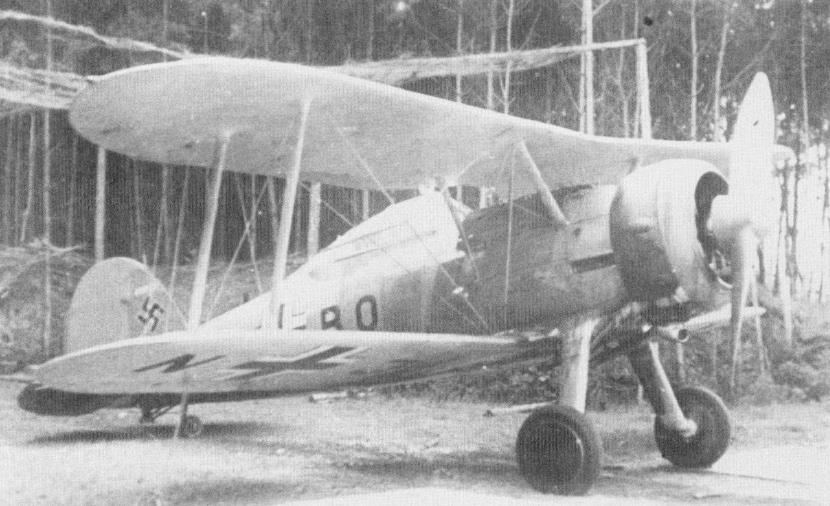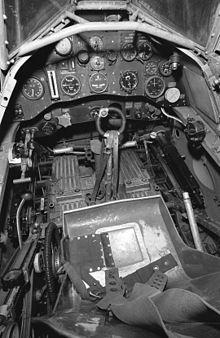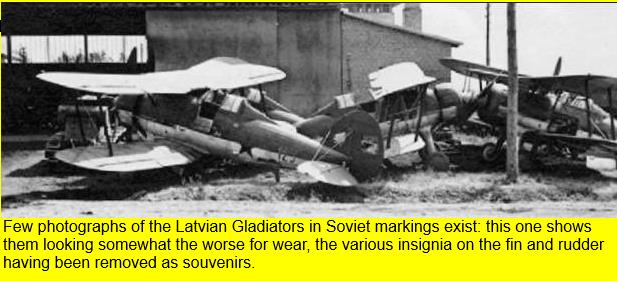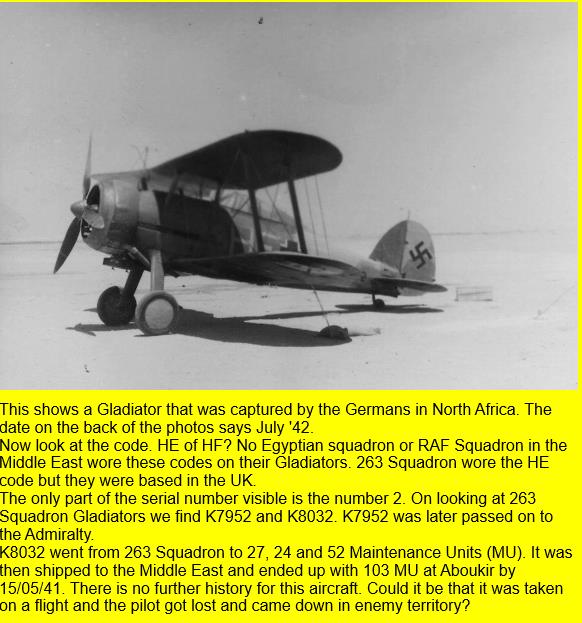Luftwaffe use of the Gloster Gladiator during the Second World War
The source for the Luftwaffe Gladiators is probably from Soviet aircraft captured during the initial part of Operation Barbarossa in June 1941. The Soviet forces had in their turn captured these aircraft during the occupation of Latvia and Lithuania in July 1940.
Within the US National Archives in Washington is a captured document listing the war materiel captured by the Luftwaffe by 1 September 1941 amongst which was listed 13 (other sources however claims that it was 15) Gladiators. Eleven of these were recorded as 'condition I/II' (airworthy or minimal damage) and two in 'condition III' (repairable at unit level). It is probable that spares such as Mercury engines were also captured. On available evidence, including known delivery dates, it is therefore now almost certain that some, if not all, of the Luftwaffe's Gladiators came from the ex-Latvian contract.
The Gladiators were dismantled and transported by train to Germany. In 1980 Anton Totzauer, an ex-Luftwaffe pilot who had served with Erg.Gr.(S) 1 recalled the "Glosters" arriving at Langendiebach by rail in a dismantled state in 1942. He stated that they wore Soviet stars but once these were removed "Finnish" swastikas became evident. As the Finnish aircraft are all accounted for, it is virtually certain that these were ex-Latvian aircraft. At this stage of the war of course, Finland was fighting alongside Germany against the Soviet Union. It is likely that Luftwaffe personnel would be aware that Finnish aircraft were identified by a blue swastika, but less likely that they would realise that the pre-war Latvian Air Force used a red swastika, so it is easy to see how an incorrect assumption could be made.
Also during the Norwegian campaign, of April 1940, some of the Norwegian Air Force Gladiators made force-landings on several frozen lakes. This was due to either combat damage or running out of fuel. Some of these may have been transported back to Germany as war booty.
The Luftwaffe's Gladiators were apparently Mk Is with fixed pitch wooden airscrews and were employed by Erganszungsgruppe (S) 1 from Langendiebach near Hanau during 1942-3. Erg.Gr. (S) 1 ('S' for Schlepp - towed) was a training Gruppe giving primary and operational training for assault glider pilots. Training was mainly conducted on the DFS230 glider. For glider towing duties however the unit used a wide variety of types, including German Arado Ar65s and Heinkel He46s, Czech Avia B-534s and the larger Letov S-328 and at least 10 Gladiators, usually described as 'Glosters'.
To have operated the Gladiators at virtually squadron strength, it is likely that the Luftwaffe acquired the type from a limited number of sources in such condition to enable their regular use. In addition, before using a type it would be probable that at least some spares backup would be required, and would also need to have been available. Within Erg.Gr. (S) 1 it would appear that the various glider towing aircraft types were used by each of the four Staffeln within the Gruppe, rather than concentrated into one. Photographic and logbook evidence has identified six aircraft by unit code:
NJ+BO (Werke Nr 45829. Egr.Gr. (S) 1 used NJ codes before adopting 1E)
1E+BL
1E+DK
1E+JM
1E+PH
1E+SH
Four Werke Nos (Wnr) allotted to Gladiators by the Luftwaffe have so far come to light:
45710 (Gloster 9. Crash-landed on 13/06/42, 80% damaged)
45717 (Gloster 5. Crashed at Langendiebach in 03/43)
45826 (Crash-landed near Babenhausen on 27/04/43)
45829 (Gloster G5 NJ+BO. Crash-landed on 15/04/42, 45% damaged)
This seems to indicate that they may have been taken into service in two batches, though this is speculative.
Four (the ones with known Werke Nr.) of the Gladiators are known to have been destroyed or significantly damaged in service with Erg.Gr. (S) 1 during 1942-3. The survivors were all authorised for deletion from the Luftwaffe inventory on 16 March 1943.
Source:
Die deutschen Gladiatoren - Karl Kössler, 1980 Modell Magazin 7/80 kindly provided by Lars Larsson
Gloster Gladiator Home Page - Alexander Crawford.
Iron Cross Gladiators: The Story of the Gloster's Luftwaffe Service - Andrew Thomas & Peter Green kindly provided by Andrew Thomas.

Following evaluation of the
Gloster Gladiator by the Latvian
Aviation Regiment in 1937, an initial
contract for 13 machines was signed that
May. The contract specified open
cockpits but was changed to include enclosed
canopies. By September 1937 a further 13
machines and 17 additional Bristol Mercury
engines had been ordered. The Gladiators were
assembled at Riga-Spilve, the first batch being
numbered 114 to 126, the second 163 to 175.
On June 16, 1940, the morning of the Soviet
invasion of Latvia, the Gladiators were dispersed
around the country but saw no combat with
Russian aircraft. Within weeks most had been
crated and shipped to Germany or Russia. On
August 17, 1940, the last three Latvian-marked
Gladiators flew as part of a Soviet-Latvian
“Aviation Festival” at Riga-Spilve.
No record of the Soviet use of the Gladiators
survives other than photographs showing several
damaged examples with red stars on their wings
and fuselages. These may date from the early
stages of Germany’s Barbarossa operation in 1941.
A document in the USA’s National Archives lists
war materiel captured by the Luftwaffe up to
September 1, 1941, which includes 13 Gladiators.
In 1980 former Luftwaffe pilot Anton Totzauer
recalled the dismantled “Glosters” arriving at
Langendiebach, near Hanau, by rail in 1942. He
stated that they wore Soviet stars but once these
were removed Finnish swastikas became evident.
The Gladiators were then employed by Ergänszungsgruppe
(S) 1 at Langendiebach for glidertowing
duties during 1942–43. Several were
destroyed or damaged in service and the survivors
were all authorised for deletion from the
Luftwaffe inventory on March 16, 1943.
| Type |
Single seat fighter |
| Engine |
1 Bristol Mercury IX with 2-bladed fixed-pitch woodenpropeller |
| Dimensions |
Length 8,36 m , height 3,58 m, span 9,83 m , wing area 30,0 m2 , airfoil RAF 28 |
| Weights |
Empty 1459 kg, loaded 2084 kg , max. take off weight |
| Performance |
Max.. speed 407 km/h at 4420 m, cruising speed 340 km/h , stall speed 85 km/hrange , endurance 2 h , service ceiling 10000 m , climb 12 m/sec., time to 3048 m 4 min. 45 sec. |
| Armament |
Two synchronised ,303 in Vickers machine guns in fuselage sides, two .303 in Lewis machine gun one beneath each lower wing. |
| Type |
Werk.Nr |
Registration |
History |
|
9/5 457 |
BC+WC |
Former Latvian/Lithuanian captured 1941 |
|
45829 |
NJ+BO |
Egr.Gr. (S) 1 |



